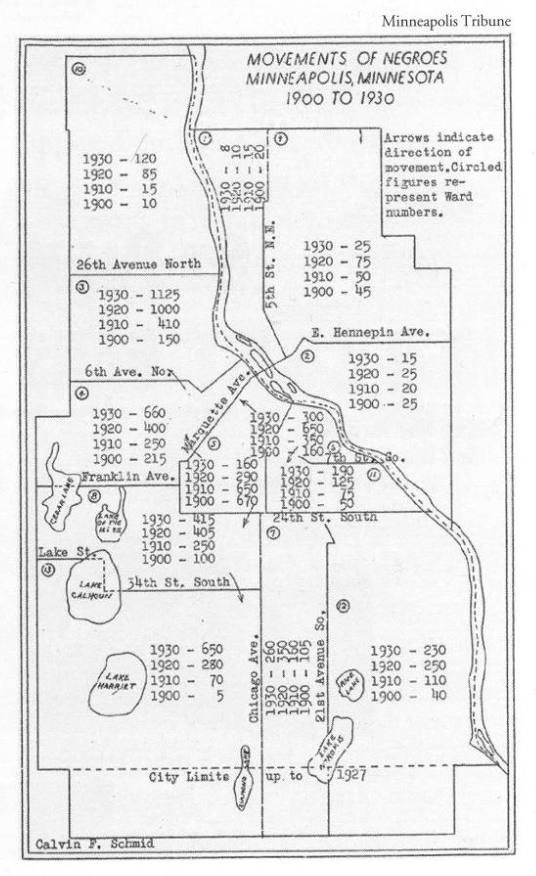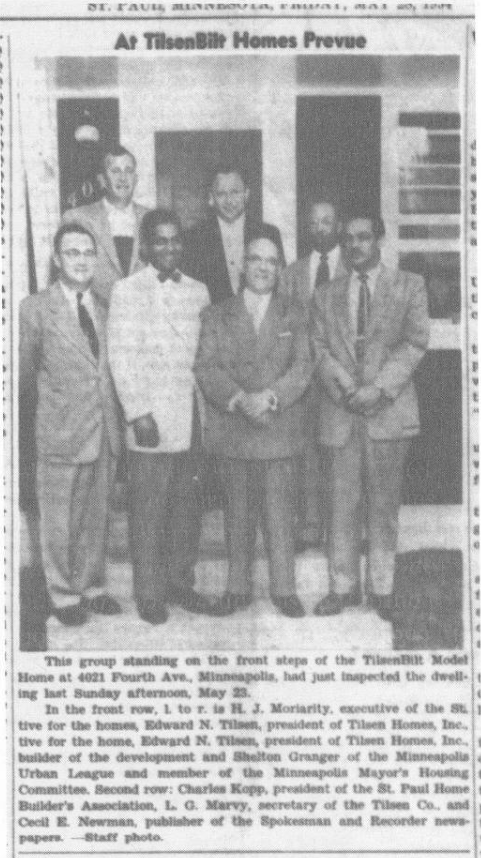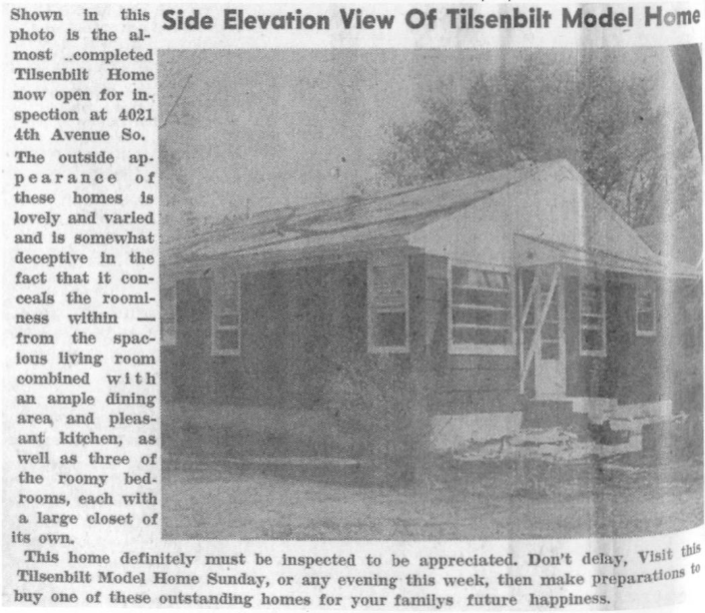Desegregating South Minneapolis Housing: Tilsenbilt Homes of 1954
by H. Lynn Adelsman
This article was originally published in Hennepin History Magazine, Spring 2005, Vol. 64, No. 2

In 1952 Camille Keller bought a home on 43rd Street and Third Avenue in south Minneapolis. Shortly after she moved in, she received a threatening letter. Her niece, Louverne Williams recalls that her aunt was targeted for being African American. “Stay north of 40th Street or else,” the letter ordered. At the time there were only two African American families living south of 42nd Street in a neighborhood that was considered by some more hostile than any other section in the city.
Open access to greater Minneapolis neighborhoods came only after years of opposition to integrated housing on the part of the white majority. Various institutions, housing developments, and individuals promoted and challenged segregated housing in south Minneapolis. In 1954, one major single-dwelling development, the TilsenBilt Homes, sanctioned mixed-race home ownership, following the lead of the Black families who lived outside the neighborhoods to which they were typically restricted. In 1954 the St. Paul Recorder, an African American weekly, reported: “In the Minneapolis residential area between 33rd and 44th Streets, Portland on the east and First Avenue on the west, a large number of the better homes are found. [There was no Interstate 35W at the time]. This area is still a mixed neighborhood despite attempts by some high-pressure real estate salesmen to stampede the white families from the area with the ‘Negro influx’ scare. Both races used this tactic.”
The National Association of Real Estate Boards (NAREB) set forth segregated housing patterns as early as 1913, advising its members not to contribute to residential race-mixing. The 1923 NAREB textbooks on real-estate practices noted, for example: “A matter of common observation is that the purchase of property by certain racial types is very likely to diminish the value of the other property in the section.” Through similar so-called gentlemen’s agreements, organized opposition to African American homeownership developed in south Minneapolis.
Real-estate companies were culpable in steering people into segregated neighborhoods. In 1946 the Minneapolis Tribune reported the response given by the president of a large real-estate company in reference to the inability of a Japanese buyer to buy a house and lot: ”Although he sympathized with members of the minority groups, most real-estate companies follow the general policy of restricting subdivisions to members of the Caucasian race in order to get high mortgages and good resale value.”
In a housing survey, the Minneapolis Urban League, a branch of the national organization, found that between 1946 and 1952, while 9,500 new homes were built in the city, “only 20 Negro families had gained access to such property as purchasers. Meanwhile the African American population grew at a rate of 60 percent from 1940 to 1950, compared with the city’s overall population increase of just 6 percent. Inflated loan rates and limited home sales in “locations not considered desirable” were some of the greatest challenges of the time, reported the Minneapolis Spokesman the local African American weekly newspaper.

Public discourse rose, in response to the housing crisis, over the need for homes to be sold on an integrated “open” market. The Minneapolis Urban League organized neighborhood councils “composed of both white and Negro residents to stabilize property, watch for zoning violations, and in general keep neighborhoods at a high standard.” The Minneapolis Urban League, like the national organization, supported African Americans in accessing quality employment, housing, education, social services and health care.
Among the earliest barriers to home ownership by Blacks were racially restrictive covenants stating the only Caucasians could own a described property. Racial covenants were usually installed by developers and supported by neighborhood associations. The U.S. Supreme Court outlawed racial covenants as not legally enforceable in 1948, in the case of Shelley v. Kraemer. This did not prevent the realtors from supporting restrictions that might read: “The premises shall not be sold, conveyed, mortgaged or leased to any person of Chinese, Japanese, Moorish, Turkish, Negro, Mongolian or African blood or decent.” This was often true for Jewish home buyers as well. As many as one-fourth of the Twin Cities may have been covered by such covenants in 1947. Katie McWatt, past St. Paul Council member and St. Paul Urban League staffer, grew up in south Minneapolis. She recalls that segregated housing was maintained through “custom and collusion, where banks, real estate agencies, lenders, sellers, and builders did not sell to Blacks outside of certain areas.”
Attempts to buy housing could result in overpricing by as much as a thousand dollars for a $15,000 home. A prospective buyer might make an appointment to look at a house only to be told, when the realtor realized the prospect was Black, that the house had already been sold. White realtors (and a few Black ones) used scare tactics to turn over housing–they encouraged whites to sell because property values might decline and the numbers of Blacks living in the neighborhood might grow. Conversely, realtors discouraged whites from selling, to avoid supposed declining neighborhood property values. Such tactics led the Minnesota Governor’s Interracial Commission on Housing, in 1947, to report “disturbing” findings that “60 percent of whites were opposed to Negroes moving into their districts. Many whites expect Negroes to be restricted to definite neighborhoods.” The commission reported that this was based on a perceived lack of peacefulness, high crime, deteriorating property appearances, and declining property values. “Some members of the white group recognize the principles of justice involved. Many do not. They must be educated as they are influenced by sense impressions.” It also noted: “Already the record shows some of the middle-class and poorer families in the Twin Cities have practiced democracy in housing. The upper-middle class and the rich are now challenged.”

Despite the barriers, in February 1954, the St. Paul Recorder reported: “In the past two years Negro-operated real-estate firms have made excellent progress in Minneapolis. In very few other Negro communities in America will one find 50 percent of the families either owning or buying homes.” In Minneapolis, Milton Shanks, a pioneer African-American contractor, built homes for Blacks. A Black farming family from Hutchinson, Minnesota, owned the successful Wormley’s Grocery Store and a private home in south Minneapolis. Scattered throughout the area were fine, two-bedroom bungalows, built in the 1920s and owned by Blacks. The same governor’s commission reported: “Statistics showed that some African-American-owned housing was decidedly better than housing occupied by some white persons in the Twin Cities.” The commission also noted that whites in Minneapolis did not oppose living next door to Blacks when they were in a domestic servant position.”
Some whites defied racist common practice and sold their homes to Blacks. In 1927, for instance, a recent widow who owned a one-year-old house on 40th and Clinton, an all-white block, agreed to sell her home to a Black couple, Robert and Eva Mallory. Although the Mallorys experienced no difficulty with financing banks often balked at financing home purchases by Blacks. Many private banks followed the same guidelines established by the real-estate industry, identifying buyers in mixed-race neighborhoods at the greatest risk for loans.
In 1933 the federal government established the Home Ownership and Loan Corporation (HOLC) program to increase home ownership and employment in the construction industries. HOLC was the first government-sponsored program to offer mortgages with a uniform repayment schedule on a large scale. HOLC systematically undervalued older central-city neighborhoods that were racially or ethnically mixed. Private banks adopted by the HOLC rating system in making loan decisions. Mapping in red the areas where even a few African Americans lived led to what we know today as redlining. This also impacted the whites who wanted to buy in mixed neighborhoods, as they might be rejected for loans in “hazardous” neighborhoods.
Unwelcoming neighbors presented another obstacle. At times community members organized petitions and presented them with offers to buy out new Black homeowners. When all else failed petitioners or neighborhood associations sometimes resorted to violence, hoping to force the buyers from their homes. They might stone the houses of new Black homeowners who did not leave, burning or otherwise damaging their property and threatening their families to move out.
In an attempt to solve the housing crisis head on, the staff at the Minneapolis Urban League met with a midwestern race-relations officer representing the Federal Housing Administration (FHA). They made a plan to build new homes for sale to all on the “open” market. N. P. Dotson, FHA representative, suggested that FHA approval might come after a realtor found property and an interested developer. Entrepreneur Archie Givens Sr., a realtor with experience in the Minneapolis Housing and Redevelopment Association, had grown up in north Minneapolis. There he saw firsthand the need to address the housing crisis. Discrimination in jobs and housing led to substandard living conditions for African Americans, especially in rental units, where only 34 percent had “standard facilities” like central heating, private plumbing, and electricity. Givens found 63 lots advertised for sale in the Minneapolis Spokesman newspaper.

Placing property ads in the Black-owned Spokesman was in contrast to the common practice of not selling property to Blacks. Mike Kelly, owner of the Minneapolis Millers baseball team from 1923 to 1946, sold the 63 lot in 1954, the year before he died. The properties sold were in an area stretching from 40th to 47th Streets, on Third, Clinton, Fourth, and Fifth Avenues South. Robert Tilsen, son of builder Edward Tilsen, said that Kelly originally bought the lots to have voting and political influence in the area south of the Nicollet Park Stadium, at Lake Street and Nicollet Avenue. The 63 lots were within and just to the south of where one of the earlier Black settlements began at 38th and Fourth Avenue. While the land for sale was thought to be of little value because of peat bogs, testing showed that just a few lots required piling to protect them against water and soil challenges.
Givens approached Edward Tilsen, one of the largest builders in the Midwest. Tilsen, a Russian immigrant born near Kiev in the Ukraine, came to the United States with his parents when he was five years old. Thriving in a career that he entered in middle age, he became regional vice president of the National Home Builders Association. In 1947 he was one of the first to build integrated apartments in St. Paul. In 1948 he attempted to build six ten-plexes in St. Paul as integrated housing. The financing bank said it would approve the loan only if each building were segregated. Tilsen declined the condition. He believed private builders had an obligation to provide decent housing to everyone, regardless of race. Givens hoped Tilsen might wish to continue his mission to expand farther into the integrated housing market. Tilsen agreed to buy the property, thus beginning the collaboration between realtor Archie Givens Sr., builder Edward Tilsen, and the Minneapolis City Urban League.
Lenders like the FHA had to be convinced that the TilsenBilt Homes were a low-risk investment. This went contrary to the FHA’s underwriting manual, which supported redlining in its documents as a means for neighborhoods to maintain stability–they must continue to be occupied by the same social and racial classes. After many meetings the FHA agreed to support the bank loan. Named after the developer Edward Tilsen, TilsenBilt homes were sold as integrated housing–possibly the first time in the nation.
Both FHA and GI mortgages were available for TilsenBilt home financing. This was a breakthrough in financing mixed-race home ownership. Between 1934 and 1962, the FHA and the Veterans Administration (VA) reportedly financed more than $120 billion worth of new housing, though less than 2 percent of this real estate was available to non-white families.
Working in the jobs available (and of those beginning to open up to Black homeowners in the area worked in civil service, at the post office, as Pullman porters and waiters for the railroad, in packing plants, at Honeywell, Federal Cartridge Corporation, T. C. Rapid Transit, the Twin Cities Ordnance, and the Minneapolis Athletic Club, as office and retail clerks, small-business owners, and more. Most professionals like doctors, dentists, and lawyers served their clients in private practice, as they were barred from local hospitals, private white practices, and legal firms.

Many white homeowners were reluctant to accept new neighbors. Tilsen personally guaranteed one woman that, if she stayed in her home for two or three years, her home would increase in value. She was not disappointed. Still, many whites did move out, resulting in what became known as “white flight.” One longtime resident who stayed was Karen Johnson, a retired Minneapolis school and bank employee. Since her birth in the 1930s she has lived on 48th Street and Clinton Avenue. She recalls how some of her neighbors moved out and thought her family unwise to stay.
The TilsenBilt Homes sold quickly, the majority to Black families, some of whom had never before owned homes. Archie Givens Jr. remembered that having a yard to play in signified a major change in his life. Before his family owned a TilsenBilt Home, they had lived in rental units. In 1954 Givens Jr. was one of the first Black students at Field School at 46th Street and Fourth Avenue. By 1964 Black students at Field represented 40 percent of the student population. But the overall percentage of students of color in the Minneapolis Public Schools was only 6.6 percent in 1963. This indicates how segregated housing fueled segregated schools.
The TilsenBilt homes challenged the racist practices and notions of mixed-race home ownerships. In 1954 the Minneapolis Spokesman described the TilsenBilt homes as “one of the most important housing programs affecting the Negro community in the history of Minneapolis.” By 1955 the Minneapolis Urban League reported: “TilsenBilt homes expanded Negro occupancy into the central parkway section of the city, which led to temporary relief from pressure on the housing market. It is not enough, but it is a first in the field of housing on an ‘open occupancy’ basis.”
